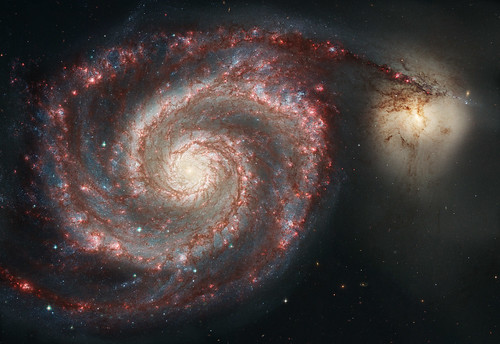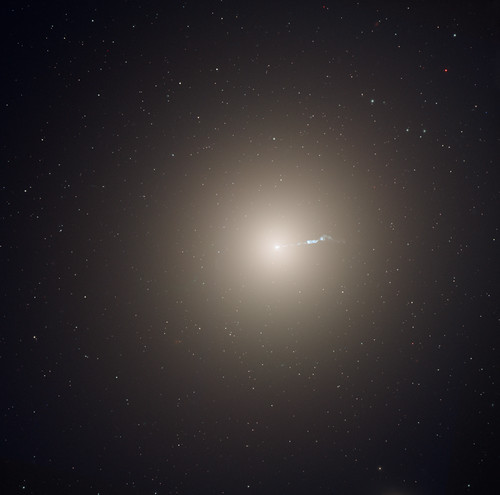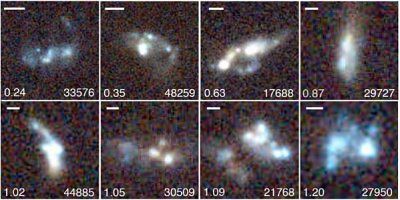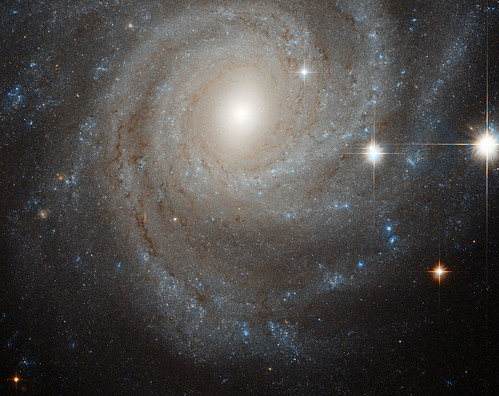Stuff You Should Know Galaxies Fact Check
JWST's unprecedented infrared sensitivity volition help astronomers to compare the faintest, primeval galaxies to today'due south grand spirals and ellipticals, helping us to sympathize how galaxies assemble over billions of years.
Galaxies Over Fourth dimension
![]()
Galaxy Interaction
−

Visible light Hubble data combined with infrared data from Spitzer, went into creating this stunning paradigm of M51, the Whirlpool galaxy. M51, as you can come across, is actually two interacting galaxies (formally NGC 5194 and 5195). Credit: vdHoeven/NASA/JPL-Caltech/R. Kennicutt (Univ. of Arizona)/DSS
Elliptical Milky way
+

Giant elliptical galaxy, M87. Behemothic ellipticals and grand spirals are idea to be the event of galaxy collisions. Credit: ESA/Hubble & NASA
- Fundamental Concepts
- In Depth
- Related Content
Why Is It Important to Sympathize Galaxies?
Galaxies show united states how the matter in the universe is organized on large scales. In order to sympathize the nature and history of the universe, scientists study how the affair is currently organized and how that system has changed through out cosmic time. In fact, scientists examine how matter is distributed and behaves at multiple size scales in our quest for this understanding. From peering into the way matter is constructed at the subatomic particle level to the immense structures of galaxies and night thing that span the creation, each scale gives the states of import clues every bit to how the universe is built and evolves.
Spirals and Ellipticals
Telescopes like the Hubble have captured many beautiful images of majestic spiral galaxies, like this one, which is called NGC 3344.
Just galaxies have not always looked this fashion. The grand spirals nosotros are so familiar with (indeed including our own) were formed over the course of billions of years past several unlike processes, including the collisions of smaller galaxies. Giant elliptical galaxies are thought to also exist formed past the procedure of similar-sized galaxies colliding [see videos linked at the lesser of the page], disrupting each other, and merging. In fact, it is thought that almost all massive galaxies have undergone at least 1 major merger since the Universe was 6 billion years former.
Clumpy Galaxies
+

Clumpy and distant galaxies spied by the Hubble. Credit: Galaxy Zoo.
How Do the Oldest Galaxies Differ?
When nosotros look at very afar galaxies, nosotros run into a completely different moving-picture show. Many of these galaxies tend to exist small and clumpy, often with a lot of star germination occurring in the massive knots. The question of how these clumpy galaxies evolve and develop structure over fourth dimension is a big open question in astronomy, and JWST will aid astronomers to learn more.
Screw Galaxy
−

NGC 3344 is a glorious screw galaxy effectually one-half the size of the Milky Mode. Credit: ESA/Hubble & NASA More than Info >
Open Questions About Galaxies
Other unanswered questions near galaxies include the following. How did the commencement galaxies form? How did nosotros end upward with the large multifariousness of galaxies we come across today? (Nosotros see non only organized and structured spiral galaxies in the modern universe, nosotros besides see those giant ellipticals we mentioned earlier, and galaxies in a wide variety of irregular shapes and sizes.)
We now know that extremely large black holes live at the centers of nigh galaxies but what is the nature of the relationship between the black holes and the galaxy that hosts them? There is also more to understand about the mechanisms that cause star formation-- whether it happens internal to a galaxy or considering of an interaction with another galaxy or merger.
1 thing nosotros practise know is that galaxies are still forming and assembling today. There are many, many examples of galaxies colliding and merging to form new galaxies. And in our ain local neighborhood of infinite, the Andromeda galaxy is headed toward the Galaxy for a likely future collision many billions of years from now! (Fun fact: space is so big that when galaxies collide, the stars within them rarely do.)
IN DEPTH
Key Questions
- How are galaxies are formed?
- What gives them their shapes?
- How are the chemical elements distributed through the galaxies?
- How practise the cardinal black holes in galaxies influence their host galaxies?
- What happens when small and big galaxies collide or join together?
JWST'due south Office in Answering These Questions
The James Webb Infinite Telescope will observe galaxies far back in time and hopefully answer these questions. By studying some of the earliest galaxies and comparing them to today'southward galaxies nosotros may exist able to sympathise their growth and development. Webb will also let scientists to gather data on the types of stars that existed in these very early galaxies. Follow-upwards observations using spectroscopy of hundreds or thousands of galaxies will help researchers understand how elements heavier than hydrogen were formed and congenital up equally galaxy formation proceeded through the ages. These studies volition as well reveal details about merging galaxies and shed calorie-free on the process of galaxy formation itself.
The Role of Dark Matter
Figurer models that scientists take made to understand galaxy formation indicate that galaxies are created when dark matter merges and clumps together. Nighttime matter is an invisible course of matter whose full mass in the universe is roughly five times that of "normal" affair (i.e., atoms). It can be idea of equally the scaffolding of the universe. The visible matter we see collects inside this scaffolding in the form of stars and galaxies. The way dark matter "clumps" together is that pocket-size objects class first, and are drawn together to form larger ones. Here is an animation that shows the dark matter distribution in the universe at the nowadays time, based on the Millennium Simulation, the largest North-trunk simulation carried out thus far!
This build-up of large systems is accompanied past the germination of luminous stars from gas and grit. Equally stars evolve, and somewhen die, they give way to new generations of stars. Scientists believe that the interaction of stars and galaxies with the invisible dark thing produced the present-twenty-four hours galaxies, organized into what is known as the "Hubble Sequence of galaxies", shown at correct.
Milky way Formation Continues
This process of milky way assembly is still occurring today - we see many examples of galaxies colliding and merging to form new galaxies. In our own local neighborhood of space, the Andromeda galaxy is headed toward the Galaxy for a possible time to come collision - many billions of years from now! Scientists today know that galaxies existed about i billion years later the Big Bang. While nearly of these early galaxies were smaller and more irregular than present-day galaxies, some are very similar to those seen nearby today.
Source: https://jwst.nasa.gov/content/science/galaxies.html

0 Response to "Stuff You Should Know Galaxies Fact Check"
Post a Comment